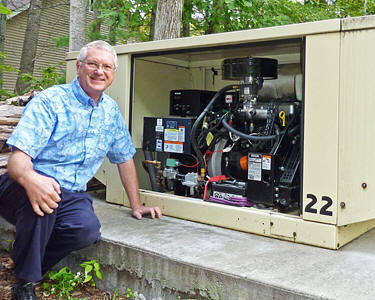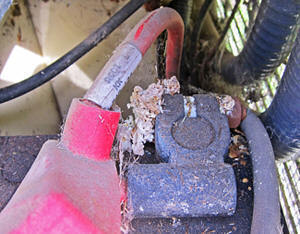|
When it comes to backup power generators,
lack of maintenance means lack of reliability.
How many times have you heard about a power outage in which a generator
failed to start? It is a common tale. Generators, often referred to as
gensets, are a serious maintenance item.
Make power generator upkeep part of your maintenance routine.
|
 |
|
Mark
Persons. "Gensets are a serious maintenance item."
|
|
Testing, 1,2,3
Most important: Test every genset online, monthly.
Test for 15 minutes. This gives the engine plenty of time to come up to
full normal operating temperature. Anything less and you are setting
yourself up for failure when the power goes out.
Your genset may have a timer to run on a weekly basis. Yes, you can
exercise the engine that way; but I recommend against having it go
online without an engineer present to pick up the pieces when things go
wrong.
Battery considerations
You need to think ahead to avoid problems when replacing a battery.
Explosions can and do happen when well-intentioned people do the wrong
thing around batteries. All it takes is an accidental short from the
positive battery terminal to ground to cause one.
Put the generator control into the off position, so there is no way for
it to start during the work. Turn off the battery charger. Disconnect
the negative battery terminal first.
This may go counter to your electronics thinking. Look at it this way:
If you are working on the positive battery terminal while the negative
is still connected to ground, an accidental short to ground could draw
many thousands of amperes of current, resulting in a battery explosion.
Ouch! With the new battery, connect the positive cable first, the
negative last.
Mark the date on a new battery for easy reference.
Often the positive battery terminals become corroded first. I don't know
why, they just do.
This is not the time go in with a metal brush to do the cleaning. I use
a plastic dustpan brush and a Shop-Vac with a plastic hose when cleaning
around batteries.
After cleanup and when installing a new battery, use battery terminal
protection of some sort. I use a red liquid that comes in an aerosol
can, available at many battery stores. The goal is to keep ugly
corrosion from growing on a battery terminal. That oxide often will
increase resistance to the cable connected to the battery. It is a bad
scene, just when you need 100 amperes of current to start the engine.
Coolant
Many gensets have sensors for water level in the radiator. If the level
is too low, they will shut down, usually after running for just a few
seconds.
Since most gensets have coolant heaters, it is normal for the coolant to
boil off with time. My feeling is that genset manufacturers go overboard
in keeping the engine hot on a 24/7 basis at your expense for the
electricity.
A typical heater is 1,000 or 1,200 watts. I like to see two coolant
heaters wired in series. They will draw half the power and still keep
the genset engine warm. Caution: You may void a genset manufacturer
warranty if you do this.
Critters
Mice are common in my part of the country. They can crawl through holes
about the size of a human finger. Mice like to chew on wire insulation
and can cost money, not to mention reliability. Best to keep them
critters out.
I use and recommend 1/4-inch hardware cloth. It is like window screen
but made of galvanized metal with openings just 1/4 inch across. The
product is available from hardware stores and easy to install over
openings to a genset.
Other stuff
|
 |
|
A
corroded battery terminal. Often the positive battery
terminal corrodes first. |
|
Diesel engines have a fuel water separator.
Best to bleed off water whenever you do maintenance.
If you find rust on an engine oil filter, you know the filter has been
in service for more than a year or two. I recommend replacing the filter
at least once every two years. Some mechanics do it annually.
Lubricate a new oil filter's rubber seal with oil before installing it.
This will keep it from leaking.
Dedicate a clipboard with a maintenance checklist to each genset you
have. Shown on this page is a list that can be modified to fit your
situation or site. A printable copy is on my website under Tech
Tips/Miscellaneous.
I don't sell Kohler backup power generators but I am a real believer in
them. The proof comes when you have an uninterruptible power supply as a
part of the generator load. My experience is that any UPS is happy with
the power generated by a Kohler.
If you discover anything odd while doing your monthly maintenance, talk
to someone who can give you answers. A genset service company is a good
place to start. Remember, a genset is no good if it won't do the job
when it is needed.
|
Backup Power Generator Maintenance Checklist
|
|
For generator at:
_____________________________________________________
site.
Engine Hours at start:___________________ At end of
work:___________________
Monthly Maintenance
Check generator for mice and other environmental
problems: ______________
Feel the engine block to see if water heater is
working: __________ (if liquid cooled)
Look for any fluid leaks: _______________
Run for 15 minutes under load: _________________
Battery Voltage: __________Volts before starting,
___________Volts while running
Oil pressure: ___________________________ Lbs
Engine temperature: __________________ Degrees F
Fuel tank level: ________________________ %
Annual Maintenance
Check/replace carburetor air filter:
_________________
Check/add engine coolant: ________________(if liquid
cooled) Quarts: _________
Check/add water in battery: ________________
Run engine for 10 minutes then replace engine oil
and filter: ______ Quarts _________
3-Year Maintenance
Replace battery
5-Year Maintenance
Run engine for 10 minutes, then:
Replace coolant: _______________(if liquid cooled)
Quarts _____________
Signature:
___________________________________________ Date:
_______________
Comments:
|
|
|
|
|



